(Words and photos by Jim Volgarino) – A true gearhead can point to some seminal moment when he or she was struck by an unexplainable epiphany. That moment when you knew things had changed and suddenly every motorized creation became a point of interest. It was that one time when you realized you’d never again look at any vehicle of transportation, play or collectability without the quickening of your heartbeat and a shortness of breath.
For Iowan Keith Larson, it was a walk past a car dealer’s lot in the late 1960s where a race worn ’64 Chevelle dirt track car resided, painted up in red, white and blue and sporting all the proverbial race car stuff…full roll cage, stinking big tires, cut out fenders.
 The race car didn’t make Larson want to go racing, however. His young mind thought, “Wow, wouldn’t it be cool to drive something like that on the street?” Speed forward 44 years and Larson has his “mechanical symphony on wheels”, but it was an 18 year journey only a gearhead could understand.
The race car didn’t make Larson want to go racing, however. His young mind thought, “Wow, wouldn’t it be cool to drive something like that on the street?” Speed forward 44 years and Larson has his “mechanical symphony on wheels”, but it was an 18 year journey only a gearhead could understand.
A race car on the street? Yup, it’s been done many times, but probably not with the attention to detail and the fine points Larson has invested in this one. He began the project once, ran out of space and patience and scrapped the project, except for some key components. It was in 1994 the project took hold and Larson started in earnest the quest to make this dream a reality.
“I tried to take a retired ’77 Camaro dirt car in 1986 and convert it to street use,” he explains. “I knew the car, found it intact in a junkyard and tried to mate a 1970 Camaro SS body to the chassis.” Larson found the task daunting at best and a family move to a different house and smaller garage pretty much killed the attempt.
“I kept a lot of parts of that race car, but couldn’t quite get the job started the right way,” he says. In ’94 things changed again, this time in favor of another attempt at “the dream”. Larson bought 400 feet of steel tubing. If he couldn’t adapt a chassis, he’d just build one. Of course, he’d never built anything like this before, but that fact wasn’t going to stop the effort.
Bolting two I-beams to the floor of his garage, Larson built a jig for the foundation of the car. With help from a friend he drew up exactly what the chassis would look like with full dimensions and hung the drawing on the back of his walk-in garage door. “I used the Camaro sub frame I had saved and built a full perimeter frame of 2×3 .120 gauge wall tubing,” he describes. “Once that was in place I went after the rest of the cage.”
Endless brackets, mounts and configurations followed to engineer what Larson had essentially dreamed up in his mind and on paper. “I had to figure out how to make everything work together and spent nearly 6 years working on it, one piece at a time,” he says. When you look over the car, you can tell he literally planned every single connection, weld and bend after a lot of thought.
“I probably have about 3000 hours in the car and half of that time was spent just trying to figure out what to do next.” Working with no instructions other than his own ideas, Larson, in classic gearhead fashion, made use of basic tools on a limited budget. “I bought a used MIG welder, chop saw and angle grinder,” he says, “and eventually had to have a mechanical tubing bender, an imported box and pan sheet metal brake and I managed to borrow a bead roller.”
Describing six years of labor can’t handle what had to be thought through every time Larson approached the chassis for another session. But he did get it rolling and on the ground. “I knew some people over at Performance Bodies in Cedar Falls who could help me with the next step so I headed their direction.”
Performance Bodies is a local company started in 1981 by racer Scott Braun who was a dirt tracker himself on the local scene. He discovered he could build, and sell, aluminum body panels to racers like himself. The company has grown to nationwide size, today handling all types of body parts and other components to keep racers supplied throughout both the racing and building seasons.
The rolling chassis was twice taken to Performance Bodies where fabricator Jeff Higgins began forming up the body. The car was delivered in both 2002 and 2008 so Higgins could mock up panels that eventually ended up in the Performance Bodies catalog so Larson’s Camaro became a prototype test bed in addition to slowly making it’s way to completion as a street driven vehicle.
In addition to the 90 pound aluminum and fiberglass body produced to cover the chassis, the original donor car provided a myriad of pieces including the front nose which had to be channeled and set back in order to arrive at the proper dimension. The car’s windshield frame and upper dash panel (including the car’s VIN plate) were incorporated along with lights, horn, turn signals and 4-way flashers.
The pre-painted panels produced by Performance Bodies kept the total paint and powdercoating budget at less than $600 for the vehicle which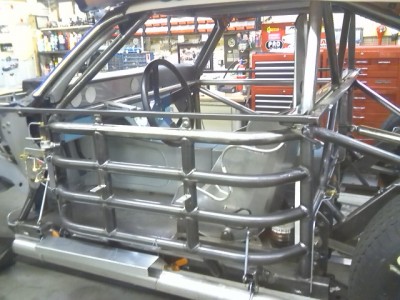 tips the scales at about 2900 pounds. Including tools purchased for the project, Larson figures he’s into the car for $15,000. “Spread over 18 years I figure that’s not too bad considering what I ended up with,” says Larson. “The car drives great, rides good and corners like a race car is supposed to and I’ve not even done any adjustments yet to the suspension.”
tips the scales at about 2900 pounds. Including tools purchased for the project, Larson figures he’s into the car for $15,000. “Spread over 18 years I figure that’s not too bad considering what I ended up with,” says Larson. “The car drives great, rides good and corners like a race car is supposed to and I’ve not even done any adjustments yet to the suspension.”
All of the fabrication inside the car came from Larson’s own hands. “My Dad was a John Deere engineer,” says Larson, “and he grew up on a farm in Kansas where there wasn’t a corner parts store where you could find what you needed. You simply learned to make it.” He obviously inherited that particular fabrication gene when he used galvanized steel for the firewall, transmission tunnel and exhaust heat shield that blocks the 3” chambered exhaust that is snaked through the door panels.
“My family included a bunch of uncles who loved nothing less than flying down dirt roads as fast as they could. I remember that well.” Larson’s family landed in Cedar Falls, Iowa when his Dad went to work for John Deere. “I started at John Deere myself right out of high school, but military service (in the Navy) called and I went to California which was car heaven for me.”
Larson worked on a series of his own rides during his Navy stint as an electrician including Corvettes, a Chevelle SS and a 1959 Mercedes. “We could work on cars at the base hobby shops for 50 cents a day,” he explains. “That pretty much got me hooked into all kinds of vehicles.” Upon discharge Larson headed back to Iowa, eventually taking a job again at John Deere, retiring after 37 years as an electrician. Now he runs a custom wheel and tire service in town and drives the Camaro to local area car gatherings when he can.
“I have about 200 miles on it,” he says and explains his need to test all the car’s systems before he embarks on anything that is much more than a safe towing distance from home. “I know the car is right, but it just takes a bit of time to get used to how it functions on the street.” Here’s hoping we get to see a lot more of it at future events and gatherings. It’s guaranteed there won’t be anything else like it when he arrives.
THE DETAILS –
Engine—In 1989 Larson found a zero mile 1970 350 LT-1 crate engine that he stashed away for future use. The 11:1 power plant was eventually torn down for new bearings and rings due to its long hibernation, but Larson says the original assembly lube was still in place. The engine is essentially stock but he says it falls easily into the 400 hp range. Fuel delivery is handled by a 750 Holley with Edelbrock Air Gap Performer intake. Stock plugs are fired by MSD ignition system. Installation included a 10” set back in the chassis using a mid plate mount and the engine is cooled via an AFCO aluminum radiator and electric fan.
Transmission—1967 Muncie with short throw Hurst Super Shifter.
Rear end—1974 Frankland quick change that came from the original dirt track car running 3:85 gear currently but Larson says a 4:47 he has for the quick change is a lot more fun. He also has 5:31 and 6:13 ratios he wants to try out. The rear is suspended using AFCO 194lb Chrysler springs and with an upper shock damper, again using the dirt track car’s original set up.
Steering—The dirt track car’s 12:1 box and linkage uses 1976 Impala spindles and lower A-arms. AFCO upperA-arms with 750lb front springs and weight jacks round out the front suspension.
Brakes—Pedals for brakes and clutch are Wilwood with pressure gauges, banlance bar and proportioning valve handling 1976 Impala calipers and rotors. The car uses a Jamar hydraulic park lock.
Exhaust—Again borrowing from the car’s heritage, the headers are Schoenfeld dirt trackers turned upside down to allow the 3” Sweet Thunder chambered pipes and mufflers to be run inside the door panels on each side, exiting outside just forward of the rear wheels.
Wiring/electrical—Ron Francis provided the harness with the front wires run inside the frame and all other wires (including battery cables) encased in ½” air hose for protection. Stock headlights and turn signals are used in addition to the rear lights which are LED semi truck. Auto Meter gauges provide all needed information from the custom built dash panel. A kill switch is mounted within reach of the passenger.
Wheels—15 x 10 Coys all around with 275/60-15 Firestone Indy 500s.








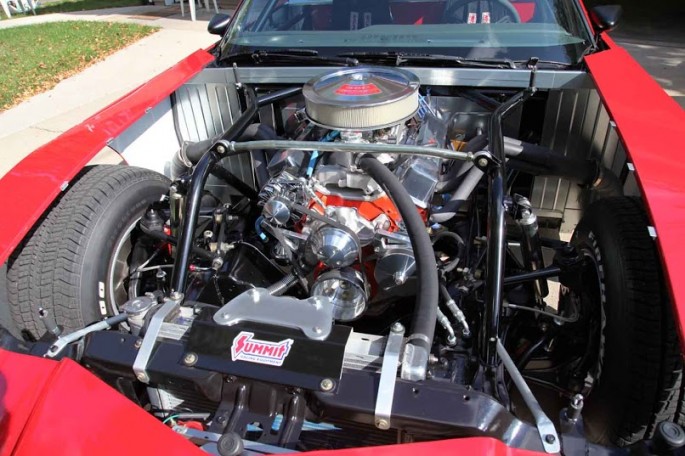
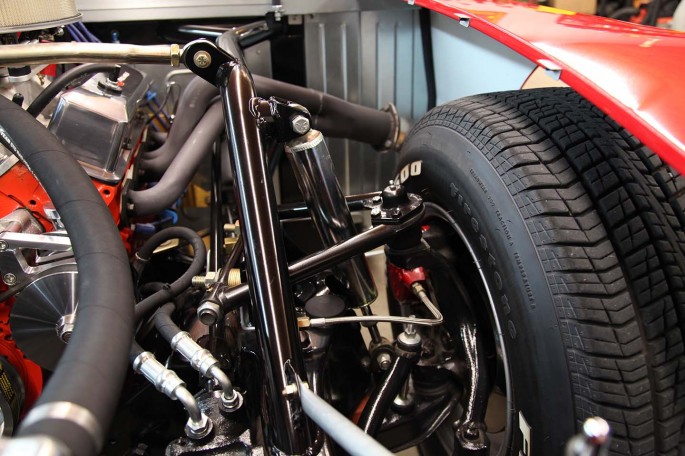

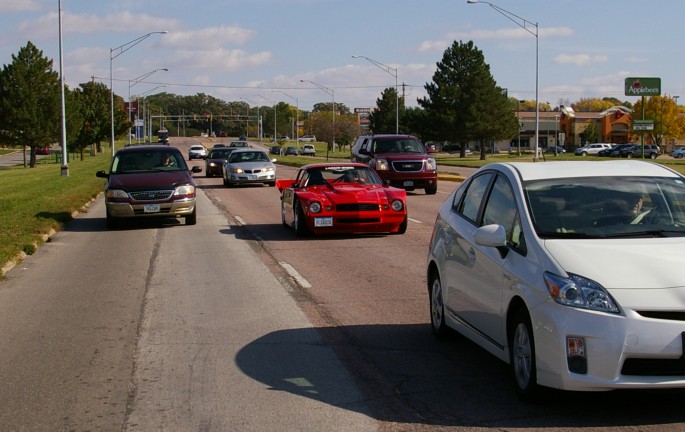
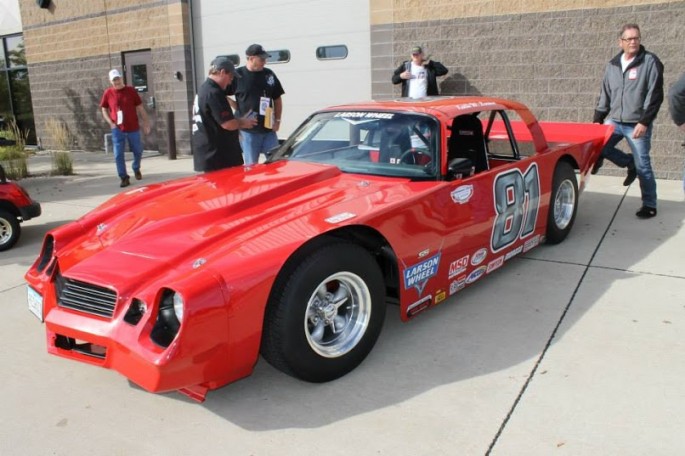
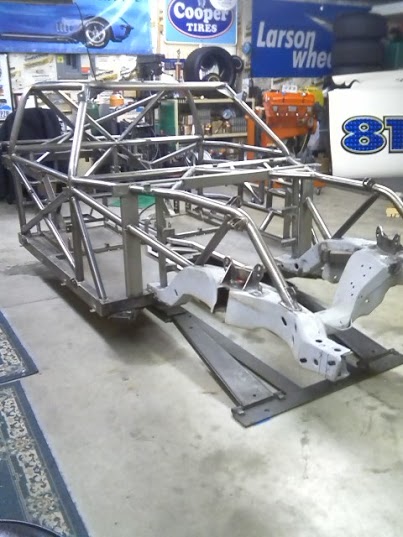
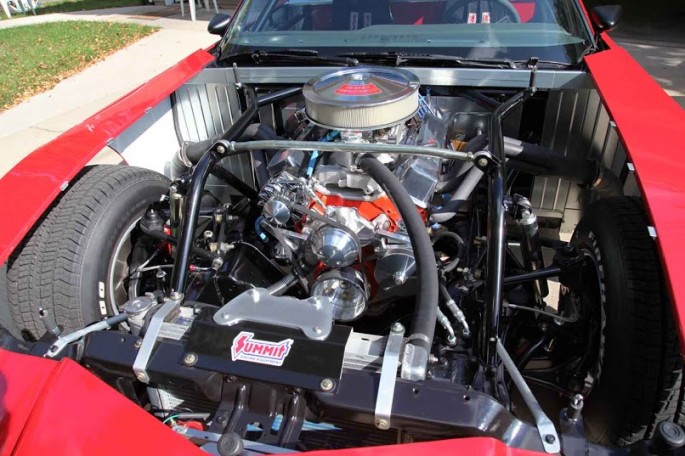


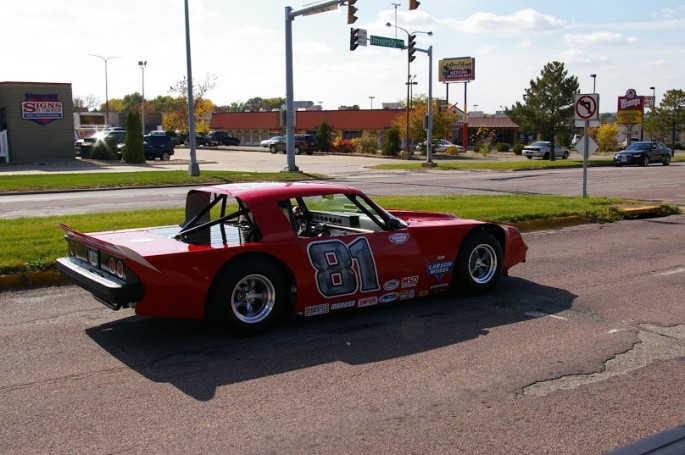
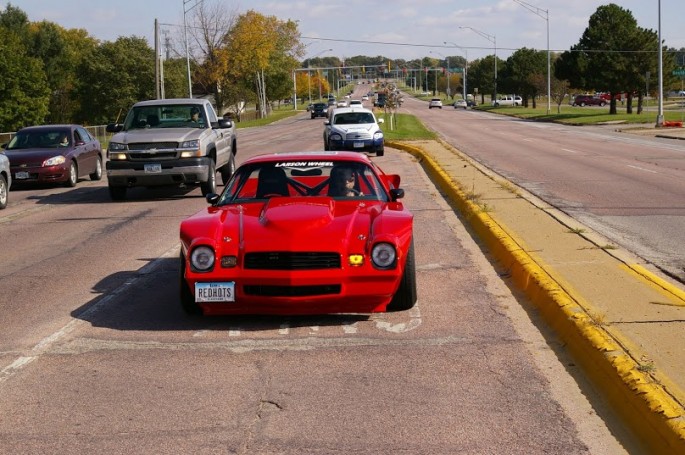
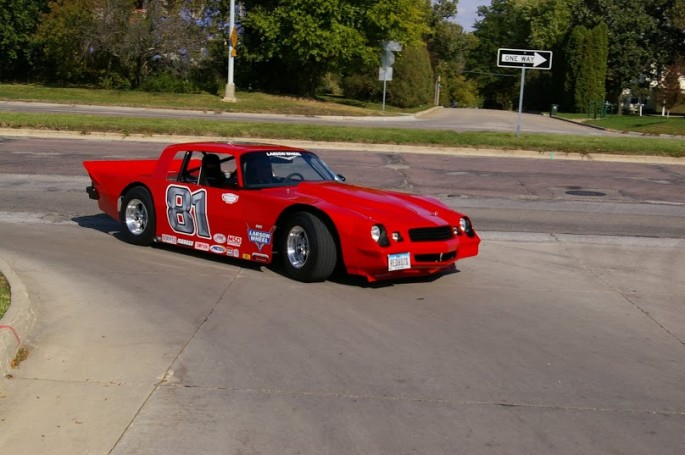





I like cars and consider myself a motor head. AutoX and land speed racing (I work for the “Da” Brain at Wilmington) are my thing but… street legal? Straight pipes, no cats, non opening doors (what I can see). Are lights and turn signals the only criteria ?Just asking.
I cant answer for other states but in Arizona the answer to your question is yes. Horn, headlights, tailights and seat belts….
as a Iowan we dont have inspections, and yes, it technically is street legal.
Really, Really Like this car, my MGB V8 is sort of a small version of it–350 sbc, 4-speed, custom frame (chassisworks stuff), same Afco radiator, the Impala front discs, 4-link rear, I am using QA1s all around, mine will weigh about 2300 lbs., it is inspirational to see this on the street, mine should be up and driving soon (less paint)
john is correct about real legality of this car, for sure here in Cal. it is not, mine is a 64 to get around the smog stuff and retains the essentials for street use
I recently aquired a 1957 Pontiac Bonneville to build a street legal dirt car, one thing I can see where money and time went is that you can now buy a pretty bent roll cage from speedway, day, or Smiley’s and save your self a lot of time and money
Just wiped a little tear of joy from the corner of my eye…it, it is glorious to behold….
I like how he used his ingenuity and perseverance and fabrication skills to get the car of his dreams a reality, it is a well done and thought out Camaro.
When I saw this car I was mesmerized by the build quality. Keith Larson said some nights he would ponder some issue for hours, trying to figure out how to do it right, many times scrapping one idea (and fabrication) and heading toward another one. It’s pure hot rodding, in my book. Yes, he has to crawl through the window to get in and out, but the car is so well done you might be willing to slide through a keyhole if you had to, just to get a ride. What a trip!
Way better than any modern-era stock car I’ve seen. Kudos. Looks like it could be a blast to drive too.
Still trying to convince the wife to let me buy this
http://seattle.craigslist.org/kit/ctd/4848657478.html
The build quality is so cool. Building a frame from scratch is a pretty daunting task and his efforts really show throughout the car. Really nice ride and first rate hot rod!!!! Really like the story on the motor too.
If you’re tempted to do something like this yourself, there’s a lot of full perimeter chassis Late Models on ebay or racingjunk that can be had for a pretty good price as well.
That would be real fuun on some twisty country roads.